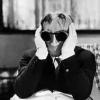Originally posted by patu:
The late Ayrton Senna tested a 1992 Penske/Chevy at Firebird Raceway at the invitation of his friend, Emmo. I recently came across a site that had pictures of this test.
Here is Senna talking to Paul Tracy (very young):

Here is Senna at the Penske:

And here is an article that appeared in Road & Track in the march issue of 1993
Senna samples the Penske-Chevy
The prospect of Ayrton Senna following Nigel Mansell to the PPG Indy Car World Series in 1993 gained additional credence when the Brazilian tested a Marlboro Penske-Chevy briefly at Firebird raceway, near Phoenix, Arizona. Senna, at the behest of close friend Emerson Fittipaldi, drove about 25 laps during a mid-December test. By about 7 laps, he was up to competitive Indy-car times. Afterward I spoke to the three-time Formula 1 World Champion:
What were your initial impressions after driving the Indy Car?
“It was a new experience for me. It was something special; it’s really good when you get to try something completely new. I really enjoyed it. I had fun, which is the most important thing for a driver.
“I have to thank Roger Penske and the team for giving me this great opportunity. It was very exciting. It’s a funny feeling for me –after so many years of driving in Formula 1- to have those feelings like you are very young, much younger than you are, which is great, you know?”
How did the car compare to your regular F1 McLaren-Honda?
“It’s more ‘driveable’. In a way it’s more for the driver, which is great. It’s how I think it should be because the public does not know whether you are going five seconds quicker or slower in lap times. The important thing is that the competition can be decided by the drivers, not the cars. I think that’s where Formula 1 has been wrong, especially last season.”
“Everything was very new to me. I had to get used to driving with a gear lever again, to a clutch pedal, to the turbo engine, and to the brakes, which are completely different from those in F1, not being carbon brakes.”
“The Penske reminded me of the old days in Formula 1 where human side was the most important thing. Today Formula 1 is so sophisticated that the computers do most of the driving for you. If you have a clever computer, you are in good shape; if you have a monkey one, you’re in trouble, you know?”
“What I experienced with the Indy car was that human input has a tremendous value –and I really got excited about it.”
Do you think the Indy Car series is correct in placing a severe restriction on technology?
“The restrictions only give a more even performance between the cars, so that is good, yes. This way the driver’s ability plays more in the final results.
“In Formula 1 during 1992,Williams was in a different world than everybody else. No matter what you did –working with the team or as a personal challenge driving over the limits in certain situations – you were between one and two seconds off. That’s crazy. Stupid.”
How did you feel about the safety aspects of the Indy car?
“Well, the car is strong. It looks strong. Of course, I think when you go the speeds that you go on the ovals, it’s tough: If you get a mechanical failure or if you make a mistake, the wall is there waiting for you. So you’d better make sure first of all you stay away from it!”
“But I think, in all honesty, one of the limiting aspects of Indy today is the safety aspect of the ovals –that in my opinion has to be improved, to preserve the men who give the show to everybody; and I believe there are always ways of improving the safety if the people corcerned are willing. That means the teams, the drivers adn the organizers need to pull together in the same direction. I think that happens in IndyCar racing.”
How much have you thought about switching to the IndyCar series?
“If I think back one year ago, I didn’t have much interest about Indy. As the year went by, given the difficulties of Formula 1 –in the political aspect of it and the sporting aspect of it- I lost a lot of my enthusiasm for F1. Emerson got me involved in this test – so it’s his fault!- and now that I have had a try, I’m getting back some of the feelings that I consider important form the mental side for me to be driving.”
I think that Senna had a lot of leverage with the FIA at the time, although they wouldn't have admitted it. Prost was non-committal towards F1, and Mansell had defected. The threat of losing Senna probably led to the rule changes that undermined his trip to Williams and precipitated his death.




















